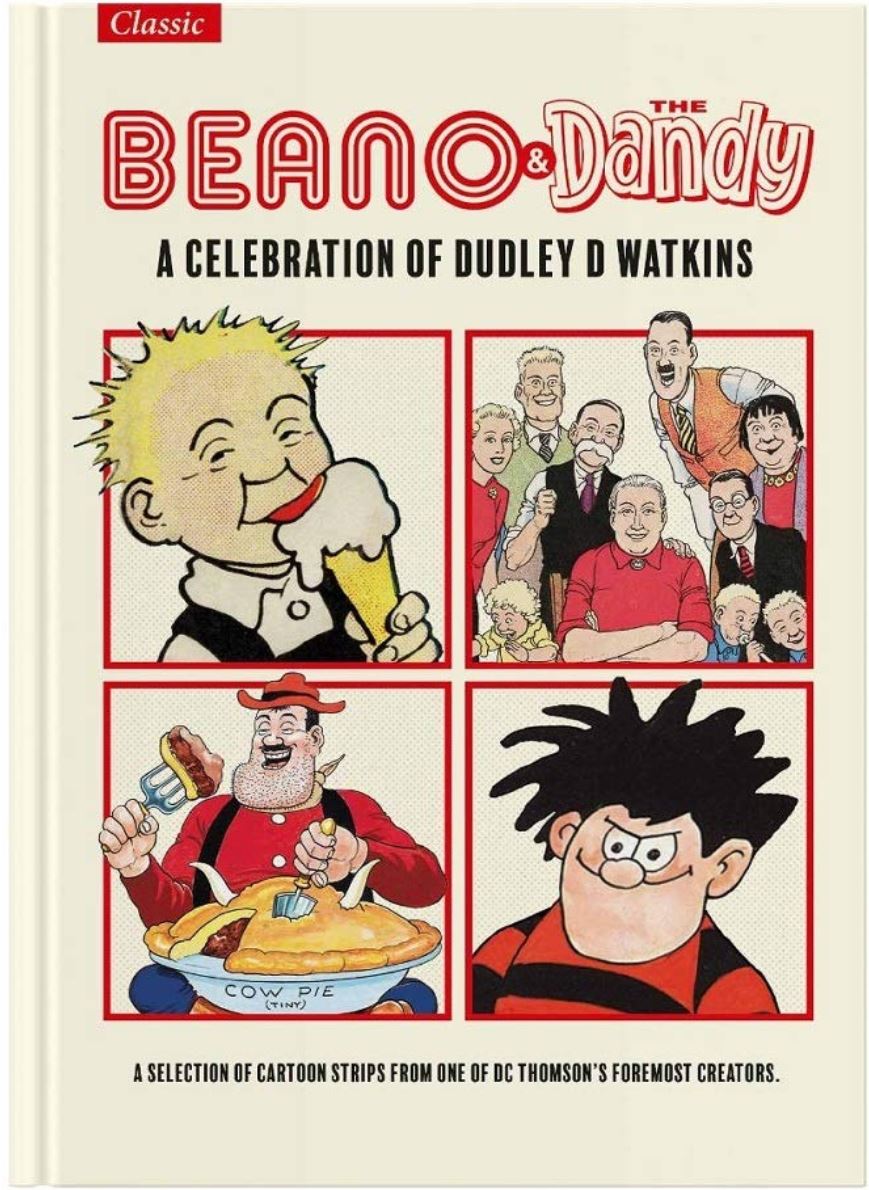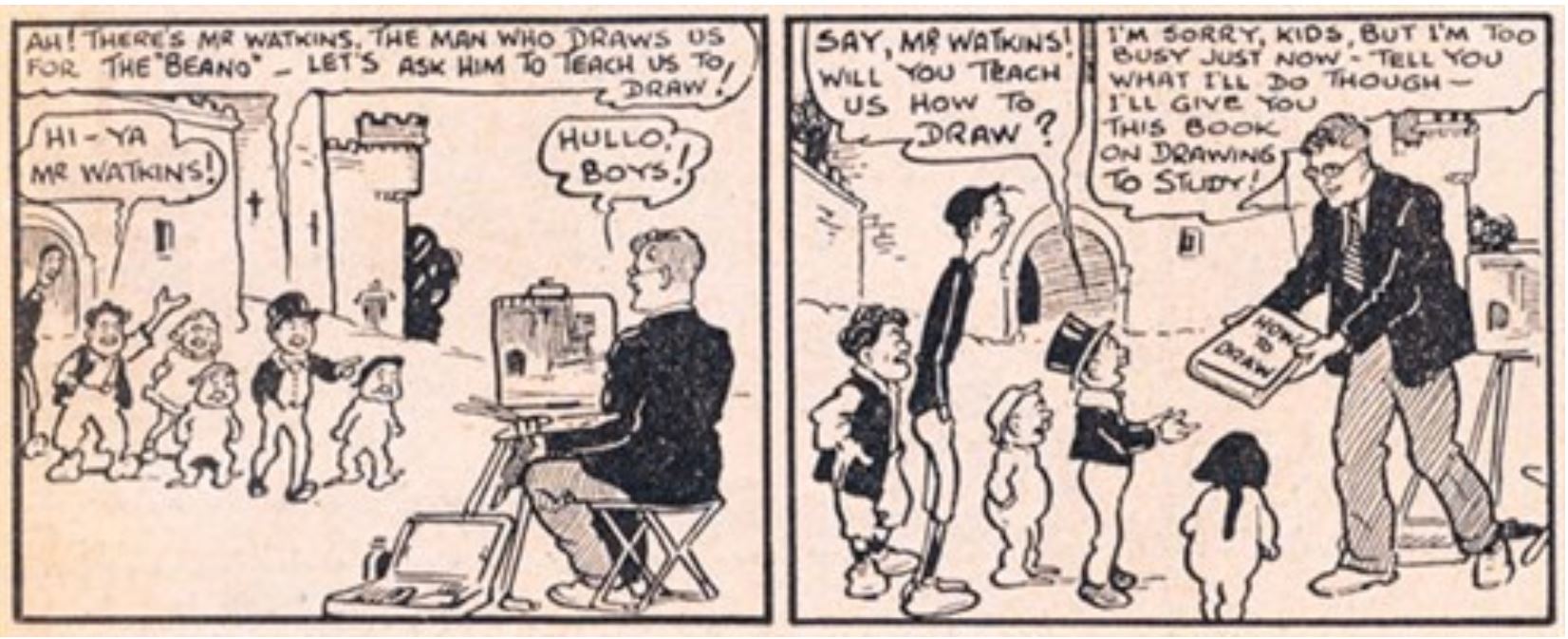
By Dudley D. Watkins, R.D. Low & various (DC Thomson)
ISBN: 978-1-84535-818-1 (HB)
This book includes Discriminatory Content produced in less enlightened times.
As the physical books I bought to commemorate this occasion still haven’t arrived yet, and none of them are available digitally, I’m celebrating the achievements of one of Britain’s greatest cartoonists with something you might have read before. So if I didn’t convince you then, here’s a another shot at what you see and what should be a compulsory text in Art, Sociology and History classes. Don’t make me repeat myself again…
Unlike any other artform, Comics is uniquely set up to create small gods. Initially low cost, mass-market and appearing with rapidity – occasionally over the course of decades – the works of some creators are instantly recognisable and generally prolific, and come to define the medium for generations of enthralled recipients. All generally defy exact duplication, despite being always heavily imitated by adoring adherents, since they possess an indefinable element that slavish imitation cannot capture: Osamu Tezuka, Hergé, Jack Kirby, Alex Raymond, Moebius, Steve Ditko and Charles Schulz are all instantly known. There are certainly a few others you’d like to add to that list.
Feel free.
My own candidate for ascension is Dudley Dexter Watkins…
A tireless and prolific illustrator equally adept at comedy and drama storytelling, his style more than any other’s shaped the postwar look and form of Scottish publishing giant DC Thompson’s comics output. Watkins (1907-1969) started life in Manchester and Nottingham as an artistic prodigy prior to entering Glasgow College of Art in 1924. Before too long he was advised to get a job at expanding, Dundee-based DCT, where a 6-month trial illustrating prose boys’ stories led to comic strip specials and some original cartoon creations. Percy Vere and His Trying Tricks and Wandering Willie, The Wily Explorer made him the only contender for both lead strips in a bold new project conceived by Robert Duncan Low (1895-1980).
Low began as a journalist for DC Thomson, rising via story scripting to Managing Editor of Children’s Publication and between 1921 and 1933 launched the company’s “Big Five” story papers for boys: Adventure, The Rover, The Wizard, The Skipper and The Hotspur. In 1936, he created the landmark “Fun Section”: an 8-page pull-out comic strip supplement for national newspaper The Sunday Post. This illustrated accessory – prototype and blueprint for every comic the company subsequently released – launched on 8th March. From the outset The Broons and Oor Wullie were the uncontested headliners.
Low’s shrewdest notion was to devise both strips as comedies played out in the charismatic Scottish idiom and broad unforgettable vernacular, supported by features such as Chic Gordon’s Auchentogle, Allan Morley’s Nero and Zero, Nosey Parker and other strips. These pioneering comics then laid the groundwork for the company’s next great leap. After some devious devising, in December 1937 Low launched DC Thomson’s first weekly all-picture strip comic. The Dandy was followed by The Beano Comic in 1938, and early-reading title The Magic Comic in 1939.
Low’s irresistible secret weapon in all of these ventures was Watkins. The indefatigable cartoon stalwart drew the Fun Section signature strips The Broons and Oor Wullie from the outset and – without missing a beat – added Desperate Dan (in The Dandy) to his weekly workload in 1937. Seven months later, placidly outrageous, subtly subversive social satire Lord Snooty became a big draw for freshly launched companion paper The Beano.
This stunning and luxurious hardback commemorative celebration was released to mark 50 years since Watkins’ death and – despite dealing with a rather solemn topic – is exuberantly joyous in tracing the man’s astounding career and output. No one could read this stuff and not smile, if not actually collapse in mirth.
Packed with brief commentary and visual extracts, the artist is revealed in excerpts and complete episodes chronologically curated to maximise his artistic development. Beginning with The 1930s, a selection of strips starring Oor Wullie and The Broons from The Fun Section is followed by a vintage full-colour Beano Book cover, before a feature on Desperate Dan leads inevitably to a tranche of wild cowboy antics in the best Dundee tradition. The system then repeats for Lord Snooty – and his Pals – and then forgotten almost-stars Wandering Willie the Wily Explorer and aforementioned Percy Vere and his Trying Tricks who share their brand of whimsy. Up until now, the majority of strips are monochrome, but the sequence starring Smarty Grandpa comes in the nostalgic two-colour style we all remember so fondly…
An introductory essay about The 1940s is followed by more of the same, but different; beginning with lost family favourite adventure series. Jimmy and His Magic Patch (latterly Jimmy’s Magic Patch) share the exploits of a wee nipper whose torn trousers were repaired with a piece of mystical cloth that could thereafter grant wishes and transport the wearer to other times and fantastic realms. Here Watkins got to impress with authentic imagery of pirates and dinosaurs, while a two-tone tale from an annual took Jimmy to Sherwood Forest and a meeting with Robin Hood…
Apparently Watkins could handle anything, as seen by a selection of book covers that follow – The Story of Kidnapped, The Story of Treasure Island and The Story of Robinson Crusoe – and illustrated general knowledge pages Cast Away!, Wolves of the Spanish Main and Soldiers’ Uniforms & Arms 1742-1755 which precede complete Jacobite adventure strip Red Fergie’s “Army”.
Once upon a time, comics offered illustrated prose yarns too, and a literary legend was a fan favourite when Watkins did the pictures. ‘Gulliver – the Paraffin Oil Plot’ has splendidly stood the test of time and neatly segues into a hefty section of strips starring the evergreen Lord Snooty and his Pals and Desperate Dan, before Biffo the Bear debuts in full colour, beginning with his premier on January 24th 1948 and including three more captivating outings. The decade closes with another prose Gulliver treat in ‘Baron Bawler’s Blackout’…
A true golden age, The 1950s section opens with Oor Wullie derivative Ginger (from The Beezer), another full-colour cover-star copiously represented and followed by fellow mischief-maker Mickey the Monkey out of The Topper, after which Lord Snooty and his Pals get the text & picture treatment for an extended (possibly Annual or summer special?) lark, and Desperate Dan & Biffo the Bear star in multi-hued shorts trips, after which ‘The Tricks of Tom Thumb’ – another classical adventure yarn – sets the scene for a veritable flurry of strips starring Biffo & Dan to see the decade out.

Venerable Lord Snooty and his Pals open The 1960s, with Desperate Dan quickly following, before more full-colourful Mickey & Ginger strips lead into what was probably the artist’s preferred material. Watkins was a committed man of faith, creating illustrated Bible tracts in his spare time, and always eager to (decorously) promote his beliefs. Here – in full colour – are a brace of theological adventure strips beginning with ‘David’ and his notorious battle, supplemented by ‘The Road to Calvary’ which lead into a rousing clan romp in the prose-&-picture yarn of English-trouncing Scots rebel Wild Young Dirky…
Ending the festival of fun, with a lump in the throat, is the Biffo strip that formed the cover of Beano #1423 (25th October 1969). Watkins had soldiered on in unassailable triumph for decades, drawing some of the most lavishly lifelike and winningly hilarious strips in comics history, and died at his drawing board on August 20th 1969. The page he was working on was completed by David Sutherland, who adds his own gracious homily to the piece.
For all those astonishingly productive years, Dudley D. Watkins had also unflaggingly crafted a full captivating page each of Oor Wullie and The Broons, as well as his church tracts and periodical commitments. His loss was a colossal blow to the company. DC Thomson reprinted old episodes of both strips in the newspaper and the Annuals for seven years before a replacement was agreed upon, whilst The Dandy reran Watkins’ Desperate Dan stories for twice that length of time.
DCT’s publications have always played a big part in Britain’s Christmas festivities and are still a cornerstone of our cultural bulwarks, so let’s revel in the Good Old Days of comics via this lovingly curated tribute to Scotland’s greatest cartoon artisan.
© DCT Consumer Products (UK) Ltd. 2020.
Hugo Pratt also died today in 1995. If you want to learn about him, our most recent review of his magic can be found here.
